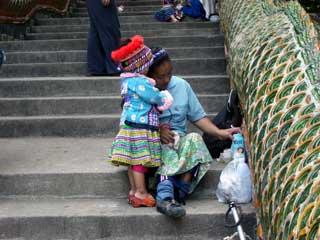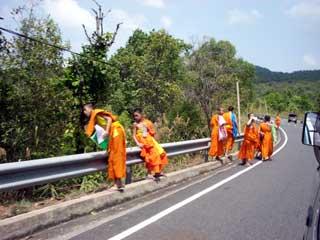 Wat Phrathat Doi Suthep
Wat Phrathat Doi SuthepJeff and Eoy at the base of the 290 steps up to the mountain top temple that is a little more than 3,500 feet above sea level.
The original temple built by King Gue-Na dates back from 1383 and the present building is believed to be 16th century. Over the years it has been expanded and restored considerably by various Chiang Mai rulers. The temple's glorious golden chedi (pagoda) contains and enshrines many sacred Buddhist relics. The cloisters are painted with bright murals depicting the previous lives of the Buddha and the marble floored area in the middle (that rises to the chedi) is filled with Buddha statues.
Legend has it that an especially holy relic was brought to Chiang Mai in 1371. To decide where it should be enshrined, it was placed on the back of an elephant, which promptly set out to climb the mountain. The elephant finally came to rest and there the relic was buried. The first chedi was built over it and the temple has been continually expanded and embellished ever since. The gold covered chedi is surrounded with a railing and at the four points of the compass are places where people can offer flowers, light joss sticks and apply small squares of gold leaf.
 Hilltribe people
Hilltribe peopleOver 100 years ago, the Hilltribe peoples migrated south from China into what are now Burma, Laos, Vietnam, and Thailand. The six major tribes are the Karen (Kariang, Yang), the Hmong (Meo), the Yao (Mien), the Akha (Ekaw), the Lisu (Lisaw), and the Lahu (Mussur). The main profession of all these tribes is farming, and all of them tend to migrate whenever they feel that the soil at their present location is becoming depleted.
Each tribe is district, with its own culture, religion, language, art, and dress. With Thailand undergoing rapid modern development, it is difficult yet to say whether these tribes will continue in there traditional ways of life, or whether they will eventually be absorbed into the surrounding, and ever more-encroaching, Thai society.
 Buddhas and Murals in the temple cloister
Buddhas and Murals in the temple cloisterThe courtyard took its present shape under Chao Kawila in 1805. It is lined by a cloister which contains Buddha images and murals depicting the life of the Buddha. In the middle of the east and west sides of the cloister are two ornate viharn. The inside walls of both are covered with murals. The murals of the eastern viharn show the legend of the elephant and the relic, while those of the western hall show the Vessantara Jataka. Devotees go to the western viharn to receive blessings and lustral water from monks sitting on a dais.
On the south and northern sides of the cloister, smaller shrines are the subject of much veneration. Thais prostrate themselves and then shake a holder with 28 sticks to see which one falls to the ground first. A fortune reading for each of the numbers may be found in a cabinet nearby.
The power of the chedi and the sanctuary attract many visitors who are invited to make merit. The sanctuary contains numerous boxes for donations to worthy causes, such as the education of the needy.

Todd, Eoy and myself
We lit candles and incense before we visited the viharn to receive blessing from the monk. I was very hot when we visited, and when the monk sprinkled us with the lustral water, I smiled and told him it felt good. The monk tied sai-sin, a plain cotton thread to my wrist and placed one on the mat for me to tie to Eoy's wrist. The monk can not hand it to her directly, because a monk is never suppose to touch a woman. The sai sin is tied around the wrist to bind the wearer to their khwan (soul).
Novice Monks
Much of Thai life centers around the local wat (temple or monastery) where people come for worship, sermons, advice on family matters, meditation, schooling for children, and traditional medicine. Many boys and men take on robes as novices or monks for short periods in order to fully immerse themselves in the Buddha's way of life. Men who choose to spend all their lives in robes receive great respect. Thais also welcome foreigners to come and practice the Buddha's teachings. The extremely supportive environment of a good Thai wat or meditation centre provides inspiration and opportunity for spiritual development that's rare in the world today.

No comments:
Post a Comment